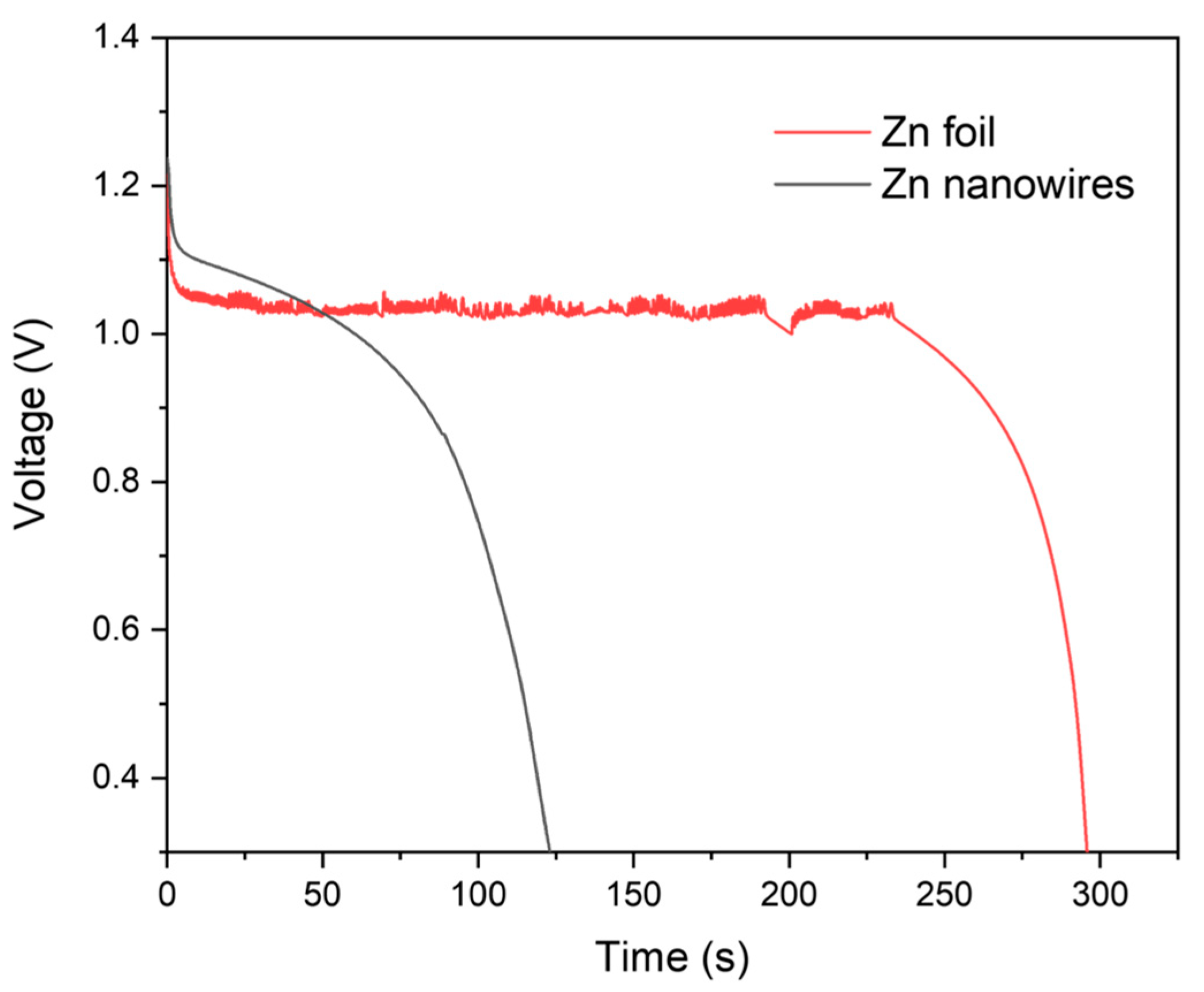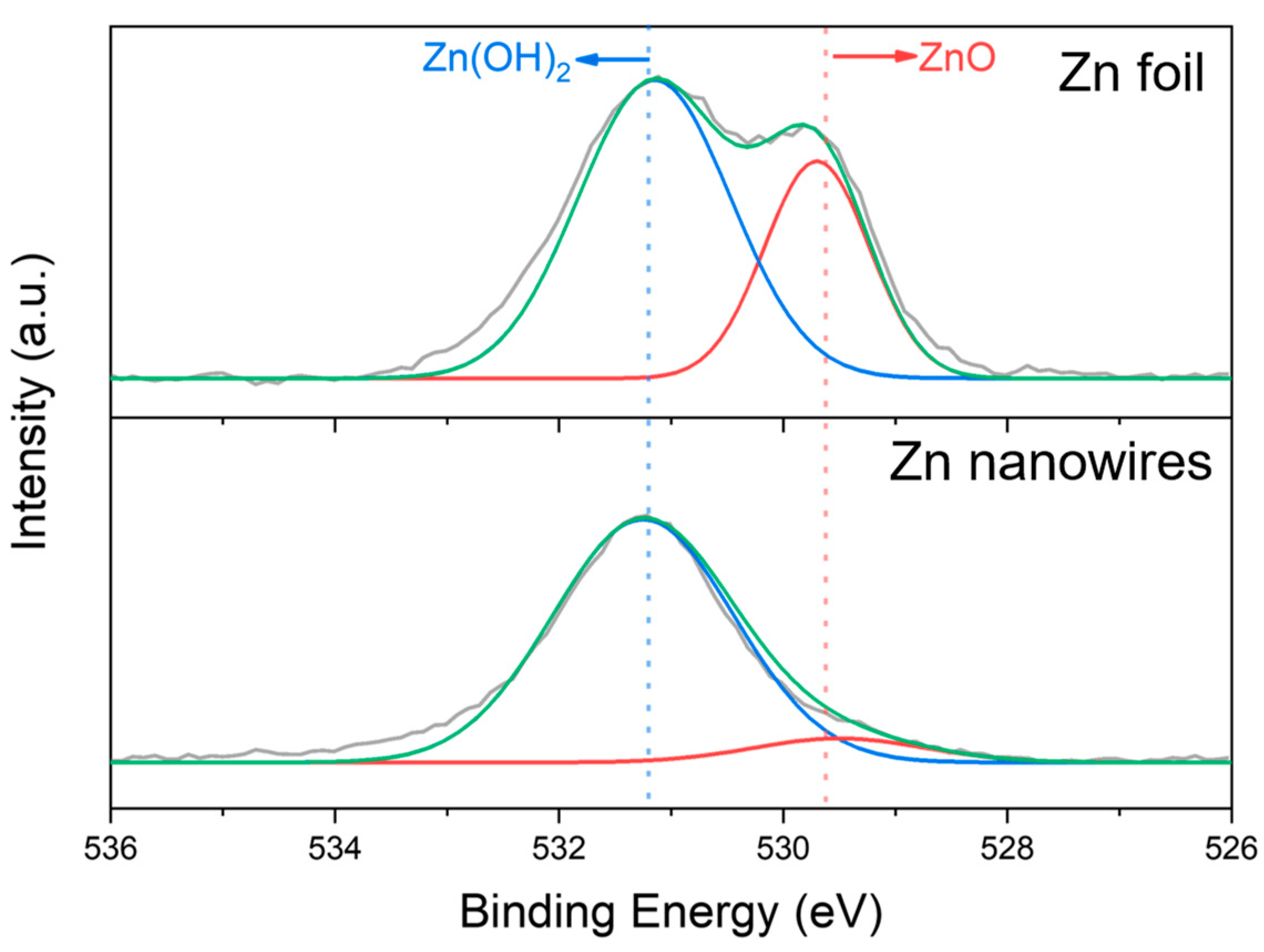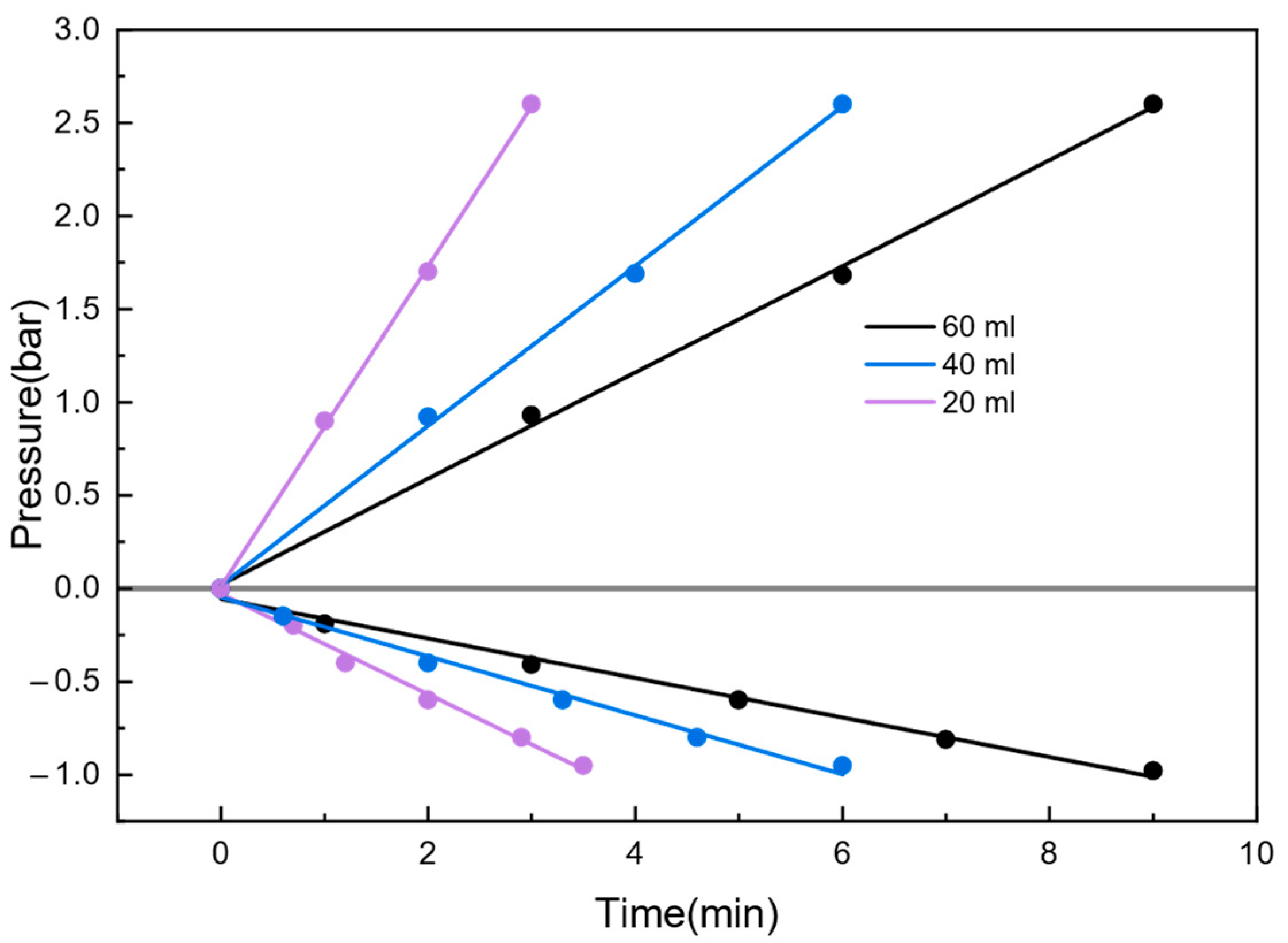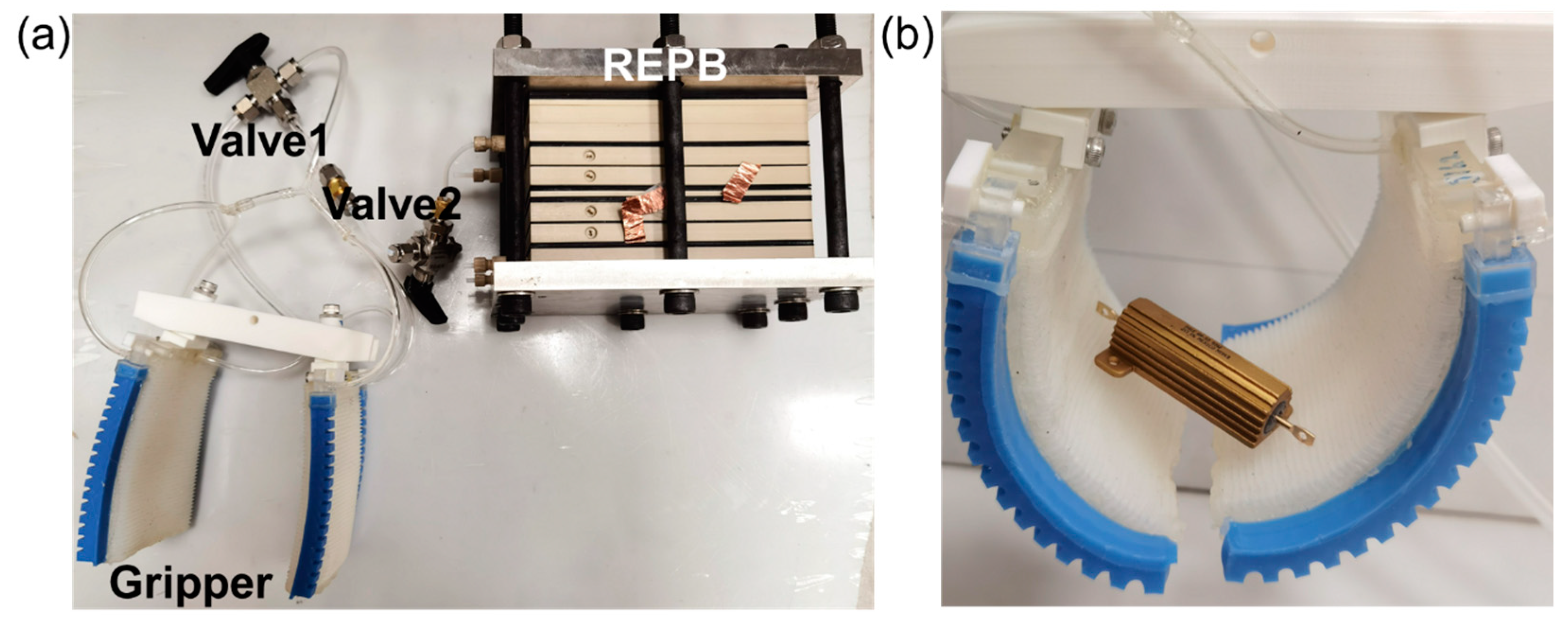Enhanced Dendrite Resistance in Reversible Electrochemical Pneumatic Batteries with Nanoimprinted Nanowire Anodes for Jamming Robots
Abstract
1. Introduction
2. Materials and Methods
2.1. Materials
2.2. Fabrication of Zn Nanowires
2.3. Reversible Electrochemical Pneumatic Battery
2.4. Design and Fabrication of Palm-Shape Variable-Stiffness Gripper
3. Results and Discussion
3.1. Comparison of Zn Foil and Zn Nanowires
3.2. Pressure Generation Ability Measurements
- z = 4 is the number of electrons involved in generating one molecule of O2,
- n is the number of moles of O2 generated,
- F = 96,000 C/mol is the Faraday constant,
- i is the charging current,
- t is the charging duration.
3.3. Reversible Electrochemical Pneumatic Battery Connection to Gripper
4. Conclusions
5. Patent
Author Contributions
Funding
Data Availability Statement
Conflicts of Interest
References
- Chauhan, M.; Chandler, J.H.; Jha, A.; Subramaniam, V.; Obstein, K.L.; Valdastri, P. An Origami-Based Soft Robotic Actuator for Upper Gastrointestinal Endoscopic Applications. Front. Robot. AI 2021, 8, 664720. (In English) [Google Scholar] [CrossRef]
- Zhang, J.; Sheng, J.; O’Neill, C.T.; Walsh, C.J.; Wood, R.J.; Ryu, J.-H.; Desai, J.P.; Yip, M.C. Robotic Artificial Muscles: Current Progress and Future Perspectives. IEEE Trans. Robot. 2019, 35, 761–781. [Google Scholar] [CrossRef]
- Wolbrecht, E.T.; Reinkensmeyer, D.J.; Bobrow, J.E. Pneumatic Control of Robots for Rehabilitation. Int. J. Robot. Res. 2009, 29, 23–38. [Google Scholar] [CrossRef]
- Papadakis, E.; Raptopoulos, F.; Koskinopoulou, M.; Maniadakis, M. On the Use of Vacuum Technology for Applied Robotic Systems. In Proceedings of the 2020 6th International Conference on Mechatronics and Robotics Engineering (ICMRE), Barcelona, Spain, 12–15 February 2020; pp. 73–77. [Google Scholar] [CrossRef]
- Adami, M.; Seibel, A. On-Board Pneumatic Pressure Generation Methods for Soft Robotics Applications. Actuators 2019, 8, 2. [Google Scholar] [CrossRef]
- Cacucciolo, V.; Shintake, J.; Kuwajima, Y.; Maeda, S.; Floreano, D.; Shea, H. Stretchable pumps for soft machines. Nature 2019, 572, 516–519. [Google Scholar] [CrossRef]
- Wehner, M.; Tolley, M.T.; Mengüç, Y.; Park, Y.-L.; Mozeika, A.; Ding, Y.; Onal, C.; Shepherd, R.F.; Whitesides, G.M.; Wood, R.J. Pneumatic energy sources for autonomous and wearable soft robotics. Soft Robot. 2014, 1, 263–274. [Google Scholar] [CrossRef]
- Wehner, M.; Truby, R.L.; Fitzgerald, D.J.; Mosadegh, B.; Whitesides, G.M.; Lewis, J.A.; Wood, R.J. An integrated design and fabrication strategy for entirely soft, autonomous robots. Nature 2016, 536, 451–455. [Google Scholar] [CrossRef] [PubMed]
- Park, Y.-L.; Santos, J.; Galloway, K.G.; Goldfield, E.C.; Wood, R.J. A soft wearable robotic device for active knee motions using flat pneumatic artificial muscles. In Proceedings of the 2014 IEEE International Conference on Robotics and Automation (ICRA), Hong Kong, China, 31 May–7 June 2014; IEEE: Piscataway, NJ, USA; pp. 4805–4810. [Google Scholar]
- Cao, C.; Gao, X.; Conn, A.T. A magnetically coupled dielectric elastomer pump for soft robotics. Adv. Mater. Technol. 2019, 4, 1900128. [Google Scholar] [CrossRef]
- Okui, M.; Nagura, Y.; Iikawa, S.; Yamada, Y.; Nakamura, T. A pneumatic power source using a sodium bicarbonate and citric acid reaction with pressure booster for use in mobile devices. In Proceedings of the 2017 IEEE/RSJ International Conference on Intelligent Robots and Systems (IROS), Vancouver, BC, Canada, 24–28 September 2017; IEEE: Piscataway, NJ, USA; pp. 1040–1045. [Google Scholar]
- Shields, B.L.; Fite, K.B.; Goldfarb, M. Design, control, and energetic characterization of a solenoid-injected monopropellant-powered actuator. IEEE/ASME Trans. Mechatron. 2006, 11, 477–487. [Google Scholar] [CrossRef]
- Shepherd, R.F.; Stokes, A.A.; Freake, J.; Barber, J.; Snyder, P.W.; Mazzeo, A.D.; Cademartiri, L.; Morin, S.A.; Whitesides, G.M. Using explosions to power a soft robot. Angew. Chem. Int. Ed. 2013, 52, 2892–2896. [Google Scholar] [CrossRef]
- Park, J.; Park, M.; Nam, G.; Lee, J.; Cho, J. All-solid-state cable-type flexible zinc-air battery. Adv. Mater. 2014, 27, 1396–1401. [Google Scholar] [CrossRef] [PubMed]
- Liu, X.; Yuan, Y.; Liu, J.; Liu, B.; Chen, X.; Ding, J.; Han, X.; Deng, Y.; Zhong, C.; Hu, W. Utilizing solar energy to improve the oxygen evolution reaction kinetics in zinc–air battery. Nat. Commun. 2019, 10, 4767. [Google Scholar] [CrossRef] [PubMed]
- Fu, J.; Lee, D.U.; Hassan, F.M.; Yang, L.; Bai, Z.; Park, M.G.; Chen, Z. Flexible high-energy polymer-electrolyte-based rechargeable zinc–air batteries. Adv. Mater. 2015, 27, 5617–5622. [Google Scholar] [CrossRef] [PubMed]
- Mainar, A.R.; Colmenares, L.C.; Grande, H.-J.; Blázquez, J.A. Enhancing the cycle life of a zinc–air battery by means of electrolyte additives and zinc surface protection. Batteries 2018, 4, 46. [Google Scholar] [CrossRef]
- Wang, F.; Borodin, O.; Gao, T.; Fan, X.; Sun, W.; Han, F.; Faraone, A.; A Dura, J.; Xu, K.; Wang, C. Highly reversible zinc metal anode for aqueous batteries. Nat. Mater. 2018, 17, 543–549. [Google Scholar] [CrossRef] [PubMed]
- Stock, D.; Dongmo, S.; Janek, J.R.; Schro, D. Benchmarking anode concepts: The future of electrically rechargeable zinc–air batteries. ACS Energy Lett. 2019, 4, 1287–1300. [Google Scholar] [CrossRef]
- Li, Y.; Dai, H. Recent advances in zinc–air batteries. Chem. Soc. Rev. 2014, 43, 5257–5275. [Google Scholar] [CrossRef] [PubMed]
- Pan, Z.; Yang, J.; Zang, W.; Kou, Z.; Wang, C.; Ding, X.; Guan, C.; Xiong, T.; Chen, H.; Zhang, Q.; et al. All-solid-state sponge-like squeezable zinc-air battery. Energy Storage Mater. 2019, 23, 375–382. [Google Scholar] [CrossRef]
- Shinde, S.S.; Jung, J.Y.; Wagh, N.K.; Lee, C.H.; Kim, D.-H.; Kim, S.-H.; Lee, S.U.; Lee, J.-H. Ampere-hour-scale zinc–air pouch cells. Nat. Energy 2021, 6, 592–604. [Google Scholar] [CrossRef]
- Ge, J.; Ding, B.; Hou, S.; Luo, M.; Nam, D.; Duan, H.; Gao, H.; Lam, Y.C.; Li, H. Rapid fabrication of complex nanostructures using room-temperature ultrasonic nanoimprinting. Nat. Commun. 2021, 12, 3146. [Google Scholar] [CrossRef]
- Zhao, Y.; Wang, Y. A Palm-Shape Variable-Stiffness Gripper Based on 3D-Printed Fabric Jamming. IEEE Robot. Autom. Lett. 2023, 8, 3238–3245. [Google Scholar] [CrossRef]
- Wang, Y.; Li, L.; Hofmann, D.; Andrade, J.E.; Daraio, C. Structured fabrics with tunable mechanical properties. Nature 2021, 596, 238–243. [Google Scholar] [CrossRef] [PubMed]











Disclaimer/Publisher’s Note: The statements, opinions and data contained in all publications are solely those of the individual author(s) and contributor(s) and not of MDPI and/or the editor(s). MDPI and/or the editor(s) disclaim responsibility for any injury to people or property resulting from any ideas, methods, instructions or products referred to in the content. |
© 2024 by the authors. Licensee MDPI, Basel, Switzerland. This article is an open access article distributed under the terms and conditions of the Creative Commons Attribution (CC BY) license (https://creativecommons.org/licenses/by/4.0/).
Share and Cite
Ge, J.; Zhao, Y.; Wang, Y.; Li, H. Enhanced Dendrite Resistance in Reversible Electrochemical Pneumatic Batteries with Nanoimprinted Nanowire Anodes for Jamming Robots. Batteries 2024, 10, 225. https://doi.org/10.3390/batteries10070225
Ge J, Zhao Y, Wang Y, Li H. Enhanced Dendrite Resistance in Reversible Electrochemical Pneumatic Batteries with Nanoimprinted Nanowire Anodes for Jamming Robots. Batteries. 2024; 10(7):225. https://doi.org/10.3390/batteries10070225
Chicago/Turabian StyleGe, Junyu, Yuchen Zhao, Yifan Wang, and Hong Li. 2024. "Enhanced Dendrite Resistance in Reversible Electrochemical Pneumatic Batteries with Nanoimprinted Nanowire Anodes for Jamming Robots" Batteries 10, no. 7: 225. https://doi.org/10.3390/batteries10070225
APA StyleGe, J., Zhao, Y., Wang, Y., & Li, H. (2024). Enhanced Dendrite Resistance in Reversible Electrochemical Pneumatic Batteries with Nanoimprinted Nanowire Anodes for Jamming Robots. Batteries, 10(7), 225. https://doi.org/10.3390/batteries10070225





